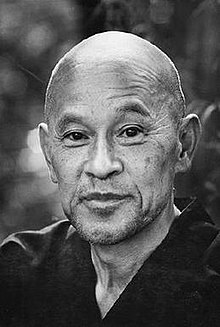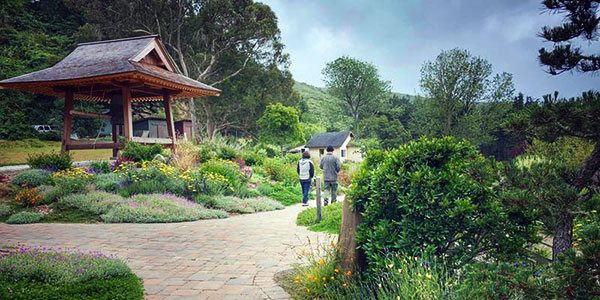Introduction
The Tassajara Zen Mountain center is the oldest Zen Monastery in America. Its name is a modification of the Spanish American word “Tasajera,” meaning “where meat is hung to dry.” It is one of three practice centers making up the San Francisco Zen Center, which was founded in 1962. The City Center is a Zen temple in the heart of San Francisco, and the Green Gulch Farm is a farm in a nearby county. Tassajara is located in a much more remote area surrounded by wilderness, so it serves as a monastery and retreat for monks training in Soto Zen. It was founded in 1966 after a major fundraising campaign, and it served as a much more effective and traditional means of Zen training for American converts, which was the initial purpose of the monastery in the first place, as intended by its founder.

Founder
Tassajara was founded by a Japanese immigrant named Shunryu Suzuki Roshi, who came to America in 1959 as a Sotoshu Zen missionary. He became a priest at Soko-ji temple in San Francisco, where he began to be exposed to American converts and Amercans that were interested in learning more about the tradition. Roshi was pleasantly surprised at the large amount of American interest in Zen, so in 1962 he and his community of practitioners started the San Francisco Zen Center, separate from the Soko-ji temple. Suzuki Roshi continued to teach Americans about Zen until he died in 1971, but not before his talks were compiled into a number of books. His books, such as Zen Mind, Beginner’s Mind and Not Always So address general Buddhist traditions such as emptiness and the Eight-fold path while also covering more Zen Buddhist teachings like our enlightened nature and sudden enlightenment. Many of his teachings are also about how to live in the moment and enjoy our lives, without being pulled down by too many worldly possessions. Although Suzuki Roshi died in 1971, the Tassajara Mountain Center still has an intact lineage of abbots that continue his legacy.

Mission Statement
The most central mission of the Tassajara Mountain Center is understandably to “express, make accessible, and embody the wisdom and compassion of the Buddha.” This entails teaching the non-duality of existence, no-self, and awakening. Their goal is inspired by the example of Buddha and guided by their founder, Shunryu Suzuki Roshi, a member of the Zen school of Buddhism. Since it is a monastery, they do strictly adhere to the sixteen bodhisattva precepts. However, their mission statement outlines the belief of members of Tassajara that lay and monastic life are expressions of the bodhisattva way. Moreover, practitioners at Tassajara are guided by three visions. Firstly, they aim to preserve and continue the legacy of their founder. This entails continuing to train people in the ways of Zen Buddhism and preserving the lineage of Roshi to ensure the ability to continue teaching for years to come. Secondly, they aim to improve upon their accessibility to increase their connections with the world and give those who are interested the opportunity to learn the ways of Zen and the teachings of their founder. Finally, they aim to preserve the integrity of their beliefs while attempting to increase access to them.
Community Relations
As covered in the introduction, Tassajara is one of three practice centers in the San Francisco Zen Center, the others being the City Center and Green Gulch Farm. Tassajara is more secluded than the other two, so its interactions with the outside community, San Francisco in particular, are limited. The City Center is more accessible to outsiders who may visit San Francisco and be interested in seeing and learning about a Buddhist temple. The center also releases a number of videos of yoga classes, Buddhist teachings, community discussions, and even weekly dharma talks often from the abbot. The Green Gulch Farm has a community of residential farmers that produce organic food for the surrounding areas and teach young farmers about sustainable agriculture. While it is a farm first and foremost, Buddhist practice certainly guides Green Gulch and its members as they live a simple life of agriculture. Tassajara itself produces videos more related to Zen practice such as zazen meditation, especially during the Covid pandemic when followers cannot gather. Prior to the pandemic, however, Tassajara would attract tourists that would support the monastery financially and learn a good deal about Buddhism and the life of monastics along the way.

Ethnic Composition
Tassajara was founded by a Japanese immigrant of the Soto school of Zen Buddhism. As a result, Japanese Buddhist culture and tradition guide the practices of the monks. For example, zazen meditation is the central form of meditation for both monks and visitors who want to learn more about Soto Zen traditions. However, Suzuki Roshi’s goal when coming to America and when starting the San Francisco Zen Center was to introduce Americans to his religion. As a result, Tassajara is comprised mostly of white converts to Buddhism from the West Coast and the San Francisco area. Since Roshi wanted to spread Buddhism to Americans that had grown up with a different religious background, acceptance of the beliefs of others is also very important to the members of Tassajara. It is their belief that the practices of Buddhism, such as meditation and mindfulness, are beneficial to people of all religions as a means of achieving mental peace and satisfaction. Roshi’s book Zen Mind, Beginner’s Mind is structured to appeal to a Buddhist that aims to follow the path to enlightenment, and is divided into sections devoted to right practice, right attitude, and right understanding. His book Not Always So describes Buddhism more philosophically, addressing concepts like emptiness and the experience of enlightenment, while also having sections devoted to living fully in the moment and calming the mind in an appeal to lay people that may be interested in the practices of Zen Buddhism but are not willing to drastically change their religious beliefs.
Conclusion
The Tassajara Mountain Center and the other two components of the San Francisco Zen Center form a rich community with admirable goals. Upon coming to American, founder Shunryu Suzuki Roshi was struck by the amount of American interest in Soto Zen Buddhism. He found that many Americans with different religious backgrounds were interested in learning about the philosophy of Buddhism as well as the practices, and a small number of those Americans were actually interested in devoting their lives to the practice. With his following of young Buddhists, Roshi constructed the first Zen Buddhist monastery in America, Tassajara, as well as an accessible temple in San Francisco and an organic, environmentally conscious community of farmers. Since then, Tassajara has brought Buddhist practices and wisdom to many more people, introducing them to the benefits of mindfulness and meditation while also teaching more interested students the ways of the bodhisattva path. In addition to spreading Buddhism to the surrounding area, Tassajara organizes volunteer work to give back to the community and improve the lives of those around them in the spirit of compassion. The Tassajara Mountain Center has opened the minds of those that are interested and improved the lives of those that might not be. Overall, Tassajara encourages an atmosphere of peace and acceptance, which is something that Americans could stand to benefit from greatly.
Sources:
https://www.sfzc.org/practice-centers/tassajara
https://global.sotozen-net.or.jp/eng/activity/temples/sfzc_1.html